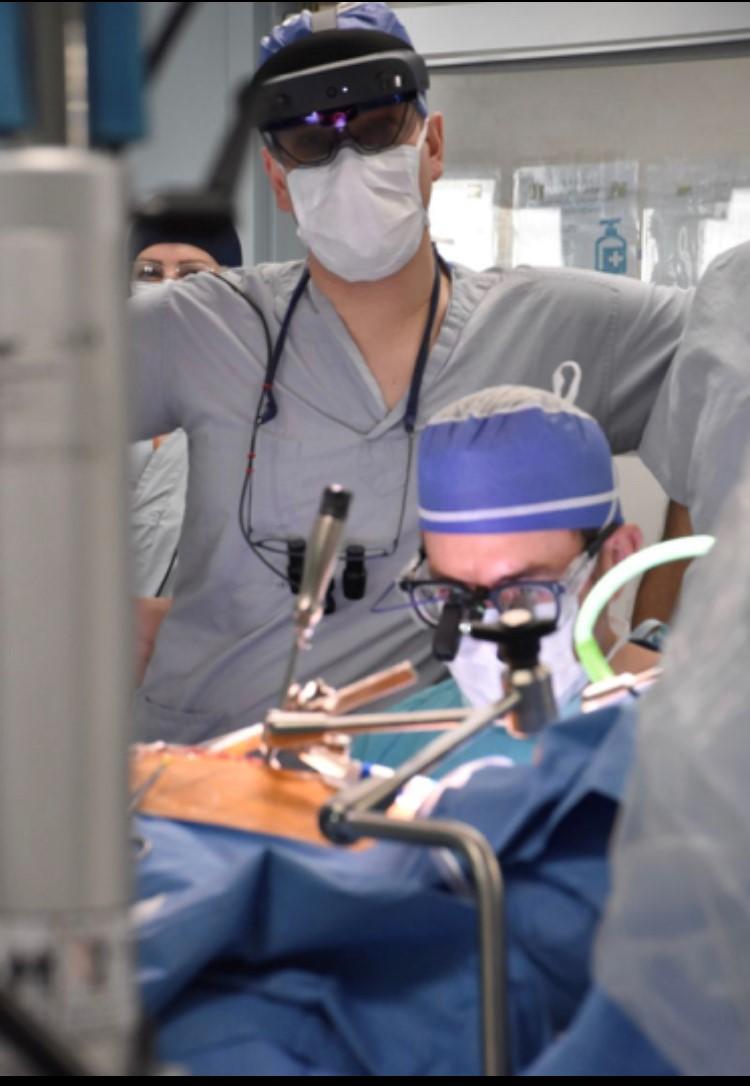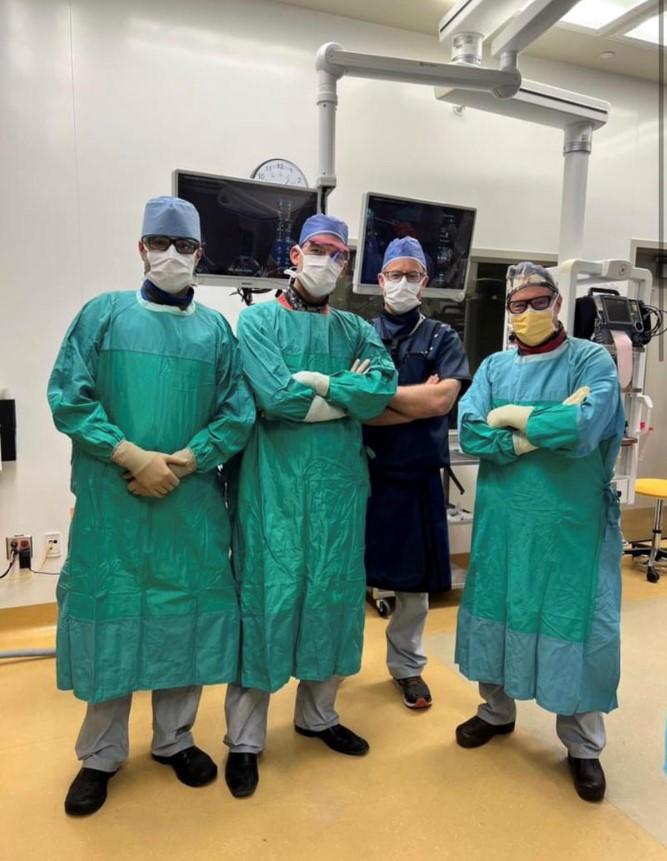About the Section of Cardiac Surgery
The Section of Cardiac Surgery performs 1,800 heart operations annually on patients from Southern Alberta, British Columbia and Saskatchewan. It is home to multiple subspecialty programs and a Royal College-accredited training program in cardiac surgery.
Section Chief
Dr. Bob Kiaii
bob.kiaii@ahs.ca
Cardiac surgery in Canada
Cardiac surgery began in Canada in the 1950s when Dr. Wilfred (Bill) Bigelow, of the University of Toronto, developed the techniques to perform a blue baby operation (Blalock-Thomas-Taussig Shunt).
Edmonton-based surgeon Dr. John Callaghan, following his training with Bigelow, used these techniques and became the first in Alberta to successfully perform open-heart surgery in 1956 with a Blue Baby Operation
.
First cardiac surgery in Calgary
Calgary’s heart surgery program began Oct. 17, 1962, when a surgical team, led by Dr. George Miller, repaired a large atrial septal defect in a nine-year-old girl at the Holy Cross Hospital. Using ice-water baths and a heart-lung machine, currently displayed on the ninth floor of the Foothills Medical Centre, the surgery was a success.
Miller grew up in Elk Point, Alberta, and earned his medical degree at the University of Alberta in 1945. After serving in the Canadian Military from 1942-1947, Miller, on the encouragement of his colleagues, trained in thoracic surgery at the Mayo Clinic under the guidance of famed surgeon, Dr. John A. Kirklin, finishing in 1954.
Cardiac Surgery at the Holy Cross Hospital
In 1956, Miller returned to Calgary and developed a cardiac surgery program at the Holy Cross Hospital with cardiologist Dr. John Morgan. The duo collaborated with Edmonton surgeon Dr. Callaghan, performing several operations between 1962 and 1965, including the first aortic valve replacement in 1968.
Dr. Stanley Goldstein was recruited shortly after. Miller and Goldstein performed the first Coronary Artery Bypass Grafting (CABG) surgery in Calgary in 1969. Shortly after, Dr. Robert Walker joined the Calgary team. The trio completed more than three hundred procedures in 1979.
Cardiac Surgery at the Foothills Medical Centre
In 1987 a second cardiac surgery unit was started at the Foothills Medical Centre. The first surgery, a CABG operation, was performed on Sept. 12, 1988. The Foothills program was led by Dr. Teresa Kieser, Calgary’s first female heart surgeon. Dr. Andrew Maitland joined the division later the same year. Dr. Baikhunt Bharadwaj, who became the chief of the division, joined the team in 1990.
The Holy Cross Hospital closed in March 1996 and the two cardiac surgery teams amalgamated at the Foothills Hospital. This led to formation of the Division of Cardiac Surgery in 2000. The Division was integrated into the Libin Cardiovascular Institute in 2004.
Cardiac Surgeons in Calgary
See below for a list of cardiac surgeons in Calgary
-
Muhammad Ahsan
Cardiac Surgeon
-
Imtiaz Ali
Cardiac Surgeon
-
Paul Fedak
Cardiac Surgeon
-
William Kent
Cardiac Surgeon
-
William T. Kidd
Cardiac Surgeon
-
Scott McClure
Cardiac Surgeon
-
Ganesh Shanmugam
Cardiac Surgeon
-
Daniel Holloway
Cardiac Surgeon
-
Corey Adams
Cardiac Surgeon
-
Holly Smith
Cardiac Surgeon
-
Bob Kiaii
Cardiac Surgeon
Cardiac Surgery Section Lead, Department of Cardiac Sciences, Calgary Zone
A special type of courage and confidence in all who are called
Dr. Teresa Kieser
Celebrated Calgary cardiac surgeon

Research
Dr. Paul Fedak’s basic science research lab studies cardiac regeneration and attracts the brightest scholars from around the world. One of the lab’s research programs is focused on boosting cell function to fix damaged hearts with the goal of improving recovery. Researchers within the lab are also investigating ways to improve chest healing after open-heart heart surgery.
The Calgary Aortic Program is heavily involved in research, publishing on topics such as endovascular aortic repair techniques. A multidisciplinary collaboration between cardiac sugery, vascular surgery, cardiology, and interventional radiology, the team seeks to advance aortic treatment strategies at a national level. The group has developed detailed procedures and outcomes with the goal of improving clinical care.
Surgical Programs
The Division of Cardiac Surgery offers the full spectrum of adult cardiac surgery, except for heart transplantation, which takes place at the University of Alberta Hospital. Coronary bypass surgery is a mainstay of treatment for heart disease. We use the Heart Team approach. By collaborating with interventional cardiologists, imaging experts and other clinicians, we improve outcomes for heart patients.
Open-heart surgery involves opening the chest at the sternum and is the traditional method. Calgary's Minimally Invasive Cardiac Surgery program uses small incisions along the sternum or in the side of the chest to repair and replace heart valves. This results in faster recovery, less blood loss and a smaller surgical scar for patients.
The aorta is the largest blood vessel in the body and operating on it is complex. The Calgary Aortic Program (CAP), which is nationally recognized, is made up of cardiac surgeons, vascular surgeons and interventional radiologists. The team takes on aortic arch and thoracoabdominal aorta surgeries as well as endovascular procedures. Co-led by Dr. Scott McClure and Dr. Randy Moore, CAP offers the highest-quality aortic surgery and the full breadth of aortic surgical procedures.
Transcatheter Aortic Valve Replacement (TAVR) involves replacing an aortic valve using a folded prosthetic valve delivered through a small hole in the patient’s groin, shoulder or directly into the chest. Using a series of continuous X-rays called fluoroscopy, the folded valve is placed into position and deployed. TAVR offers an attractive option for patients who are too frail for traditional heart surgery. Calgary’s TAVR team includes Dr. Daniel Holloway and Dr. Corey Adams who work in collaboration with interventional cardiologists.

Education and Curriculum
Our six-year program is nationally renowned, attracting the top candidates from around the country. It is structured so our surgical residents get lots of clinical exposure and have opportunities for academic training. In the first five years of the program, trainees do rotations in numerous areas such as adult and pediatric cardiac surgery, our intensive care units, cardiac electrophysiology and general cardiology. This approach gives trainees exposure to surgeries in numerous areas of cardiac surgery.
Trainees also receive one year of academic training, which can be extended. This helps residents develop complementary skills and identify a desired career path.
The main requirement of our program is that applicants have a keen interest in cardiac surgery. We use a multimodal evaluation strategy to fairly assess applicants to the program. Our interview includes a situational judgement test, a virtual multiple mini-interview and a panel interview.
Program Director
Dr. Muhammad Ahsan
muhammad.ahsan@albertahealthservices.ca
Equity, Diversity, and Inclusion Statement
As per the recommendations set forth by the University of Calgary Postgraduate Medical Education Office, the residency program will support equity, diversity, and inclusion in our resident selection process by ensuring that:
- All assessors are trained in implicit bias, anti-racism, and anti-oppression.
- All assessors are trained in identifying and avoiding conflicts of interest.
- Our selection system is designed to recognize and mitigate selection bias.
- Emphasis on assessment of mandatory personal data provided by applicants (i.e., name, school(s) of graduation, gendered pronouns) is either decreased or all together removed.

